Diego Urbina, ex-Mars500 crewmember and current member of the CAVES support team, tells us what it was like to take part in the CAVES 2013 dry run in June:
I opened my eyes that night. I had just had one of those dreams that shake you out of sleep for a couple of seconds, but that normally let you go back to sleep straight away.
This time, however, when I opened my eyes, I couldn’t see anything at all.
Intrigued by this profound and unusual darkness, I kept my eyes open for longer than usual, expecting to detect a tiny ray of light from a phone charger, or the muted headlights of a car passing in the street, or just that handful of photons that enter your eyes once you get used to the darkness.
Nothing.
After a few seconds (though it seemed much longer than that), I realized I wasn’t in my bed, nor at a normal camp site, but in the bowels of the Earth, on a sandy patch of ground inside a naturally formed hole that runs 1 kilometre deep into a mountain on a Mediterranean island.
In February 2013 I became part of an ESA team that prepares astronauts for the wonderful but sometimes unforgiving conditions of space. Headed by Loredana Bessone, the team trains the astronauts of the International Space Station programme, subjecting them to conditions that in many ways are similar to those in spaceflight.
A place that provides a great example of these harsh conditions is a system of caves in Sardinia, where we went last month to rehearse what the astronauts will go through in September during the course, and to test the scientific procedures they will carry out.
The caves are difficult to enter (at least for a non-speleologist) and difficult to get out of, maybe even more so than the Space Station itself would be in an emergency situation.
Various expert mountaineers will assist the astronauts – as they assisted and Stefan Leuko (microbiologist) and I – during the physically exhausting 4-hour journey to the base camp. Francesco and Alessio efficiently ensure that no mistakes are made with the cave progression tools: using the wrong techniques could put the trainees in grave danger. Fortunately the training we received was fantastic, and we completed the long journey successfully, just as the CAVES astronauts of previous years have done.
Part of my role in the CAVES project involves integrating scientists’ requests for experiments in a way that is relevant for space exploration. This has led me to interact quite a bit with the CAVES scientists, all worldwide experts in their fields (geology, the environment, biology and microbiology). I’ve been treated to myriad stories from their expeditions underground and in remote places.
I came to the caves this time to put to the test the procedures the astronauts will carry out. I also came to see where they will be walking, crawling and descending, because I will be their only contact with the outside world through both a rudimentary phone line and a high tech radio that penetrates the ground (I will be the equivalent of what in ISS operations we call the CAPCOM or EUROCOM, and I am currently following EUROCOM training myself).
After reaching the basecamp, we rested a bit and had an evening meal just as you would if you were camping, except that above me were not stars but rather a whole mountain. Thinking of just how much mass of rock you are under really does put things into perspective and makes you hope that not one single little rock falls from that high ceiling. Later, you forget about it and just enjoy discovering the cave, in spite of its location and the physical effort needed.
Sleeping in the cave is not as uncomfortable as you might think: it really is just like camping. What I recall the most is the darkness and the silence. And also the peace of mind that comes from knowing that not a lot can live down there, so there’s no need to worry about wolves, bears or even mosquitoes. Of course, there are certain oddities of nature to contend with, like drops of water that sounded like a barking dog (!) every time they fell on a particularly musical piece of the cave floor.
Not even waking up in the middle of the night bothered me. Instead, I was fascinated by this total darkness that is so deep that in the end, it forces you to close your eyes and keep dreaming. This new world was so impressive that it was easy to dream all night about the caves themselves and their beautiful formations.
The next day we roamed around the cave, visiting particular locations with our scientific equipment. We were carrying out science tests in such beautiful places that it was even a bit distracting! Our cameramen Sirio and Vittorio are experts on how to make these places look great on film.
The working day was pretty exhausting, which made it hard to think about how we still had to go through 4 hours of ascents, descents and translations on wet walls in order to get back! However, it’s true that practice makes perfect, and even though we had only had 4 hours of experience, getting out was easier than getting in.
My trip into the cave was just a fraction of all the work we had to do during the dry-run week: we also had to prepare lessons, equipment and the external setup. But it was definitely this experience that made the biggest impact on Stefan and I, as it was our first time in the cave.
On a more mundane note, every time I wake up in the middle of the night now, I can’t help but count and identify all the sources of light I can see – no matter how tiny they are – in my “completely dark” bedroom in Cologne, Germany. Compared to the darkness I experienced in the CAVES dry run, my dark room now looks like a flashy discotheque.

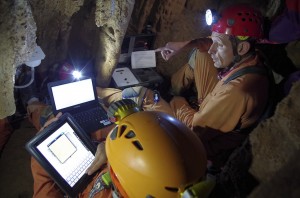
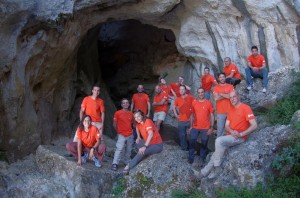
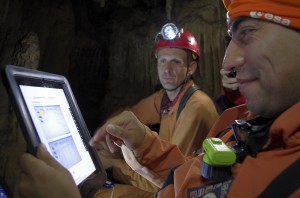
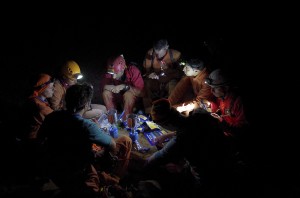
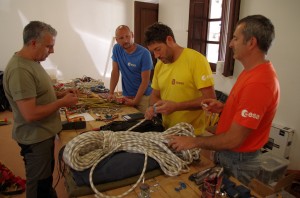
Discussion: no comments